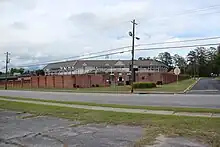Thomson Orioles
The Thomson Orioles were a minor league baseball team based in Thomson, Georgia. In 1956. Thomson played the season as members of the Class D level Georgia State League, which permanently folded following the completion of the 1956 season. The Orioles qualified for the league playoffs. Thomson hosted home minor league games at The Brickyard. The Thomson Orioles were so nicknamed, as the team was a minor league affiliate of the Baltimore Orioles.
| Thomson Orioles | |
|---|---|
| Minor league affiliations | |
| Class | Class D (1956) |
| League | Georgia State League (1956) |
| Major league affiliations | |
| Team | Baltimore Orioles (1956) |
| Minor league titles | |
| League titles (0) | None |
| Wild card berths (1) | 1956 |
| Team data | |
| Name | Thomson Orioles (1956) |
| Ballpark | The Brickyard (1956) |
History
In 1920, Thomson, Georgia fielded a team in the semi–professional North Georgia League. Thomson was in 1st place in the league with a 20–5 record in standings posted on July 15, 1920. Thomson won the first half pennant in the league and played Elberton, winners of the second half pennant, in the finals.[1] [2]
Thomson first hosted minor league baseball in 1956, as the Thomson "Orioles" began play. The newly formed Thomson franchise became members of the six–team the Class D level Georgia State League, in the league's final season of play.[3] The Thomson Orioles were a minor league affiliate of the Baltimore Orioles. The Thomson Orioles joined the Douglas Reds, Dublin Irish, Hazlehurst-Baxley Tigers, Sandersville Giants and Vidalia Indians in Georgia State League play. Thompson replaced the Statesboro Pilots franchise, who had folded from the league in 1955.[4][3][5]
The Thomson Orioles placed fourth in the 1956 Georgia State League final standings and qualified for the playoffs. Thomson ended the Georgia State League regular season with a 61–59 record, playing under managers Enid Drake and Barney Lutz. Thomson finished16.0 games behind the first place Douglas Reds in the final standings.[6] In the 1956 playoffs, the Sandersville Giants defeated Thomson 3 games to 2 in their first–round series. The Georgia State League permanently folded after completing the 1956 season.[7][5]

Attendance issues were a contributing factor in the Georgia State League folding following the 1956 season. The Thomson Orioles season home attendance at The Brickyard was 40,849, an average of 681 per game, leading the Georgia State League in attendance. Thomson drew 8,000 more fans than the second ranked team in home attendance.[8]
Thomson, Georgia has not hosted another minor league team.[7][6]
The ballpark
The Thomson Orioles team played minor league home games at The Brickyard.[9] Reportedly, the facility was built with remaining brick from the Thomson High School building, which was struck by lightning and destroyed in 1937. Today, the facility is still in use as home to Thomson High School athletic teams. The original baseball grandstands have been removed. The Brickyard stadium is located at 612 Main Street Thomson, Georgia.[10][8]
Year–by–year record
| Year | Record | Finish | Manager | Playoffs/Notes |
|---|---|---|---|---|
| 1956 | 61–59 | 4th | Enid Drake / Barney Lutz | Lost in 1st round |
Notable alumni
- Lloyd Brown (1956)
- Fred Hofmann (1956)
- Roger Marquis (1956)
See also
Thomson Orioles players
References
- "The Barrow Times - Standing of the Clubs. p.1". July 15, 1920.
- "The Barrow Times - Washington takes 3, the ball season over. p.1". August 26, 1920.
- "1956 Georgia State League". Baseball-Reference.com.
- "1955 Georgia State League". Baseball-Reference.com.
- Johnson, Lloyd; Wolff, Miles, eds. (2007). The Encyclopedia of Minor League Baseball (Third ed.). Baseball America. ISBN 978-1932391176.
- "1956 Thomson Orioles Roster on StatsCrew.com". www.statscrew.com.
- "1956 Thomson Orioles Statistics". Baseball-Reference.com. Retrieved 2018-10-30.
- "The Brickyard". www.visitthomsonga.com.
- "The Brickyard (City Park) - Thomson Georgia - Former Home of the Thomson Orioles". digitalballparks.com. Retrieved 2018-10-30.
- "Events | Thomson High School". ths.mcduffie.k12.ga.us. Retrieved 2018-10-30.